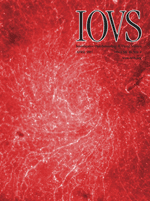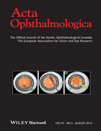
Ophthalmology is a clinical and surgical specialty within medicine that deals with the diagnosis and treatment of eye disorders. A former term is oculism.

A cataract is a cloudy area in the lens of the eye that leads to a decrease in vision of the eye. Cataracts often develop slowly and can affect one or both eyes. Symptoms may include faded colours, blurry or double vision, halos around light, trouble with bright lights, and difficulty seeing at night. This may result in trouble driving, reading, or recognizing faces. Poor vision caused by cataracts may also result in an increased risk of falling and depression. Cataracts cause 51% of all cases of blindness and 33% of visual impairment worldwide.

Strabismus is a vision disorder in which the eyes do not properly align with each other when looking at an object. The eye that is pointed at an object can alternate. The condition may be present occasionally or constantly. If present during a large part of childhood, it may result in amblyopia, or lazy eyes, and loss of depth perception. If onset is during adulthood, it is more likely to result in double vision.
Anterior ischemic optic neuropathy (AION) is a medical condition involving loss of vision caused by damage to the anterior portion of the optic nerve as a result of insufficient blood supply (ischemia). This form of ischemic optic neuropathy is generally categorized as two types: arteritic AION, in which the loss of vision is the result of an inflammatory disease of arteries in the head called temporal arteritis, and non-arteritic AION, which is due to non-inflammatory disease of small blood vessels. It is in contrast to posterior ischemic optic neuropathy, which affects the retrobulbar portion of the optic nerve.
Vision therapy (VT), or behavioral optometry, is an umbrella term for alternative medicine treatments using eye exercises, based around the pseudoscientific claim that vision problems are the true underlying cause of learning difficulties, particularly in children. Vision therapy has not been shown to be effective using scientific studies, except for helping with convergence insufficiency. Most claims—for example that the therapy can address neurological, educational, and spatial difficulties—lack supporting evidence. Neither the American Academy of Pediatrics nor the American Academy of Ophthalmology support the use of vision therapy.
Vision science is the scientific study of visual perception. Researchers in vision science can be called vision scientists, especially if their research spans some of the science's many disciplines.

JAMA Ophthalmology is a monthly peer-reviewed medical journal covering all aspects of ophthalmology. The editor-in-chief is Neil M. Bressler. It is published by the American Medical Association, with which it has been affiliated since 1929.
Stargardt disease is the most common inherited single-gene retinal disease. In terms of the first description of the disease, it follows an autosomal recessive inheritance pattern, which has been later linked to bi-allelic ABCA4 gene variants (STGD1). However, there are Stargardt-like diseases with mimicking phenotypes that are referred to as STGD3 and STGD4, and have a autosomal dominant inheritance due to defects with ELOVL4 or PROM1 genes, respectively. It is characterized by macular degeneration that begins in childhood, adolescence or adulthood, resulting in progressive loss of vision.

Investigative Ophthalmology & Visual Science (IOVS) is an online journal published by the Association for Research in Vision and Ophthalmology (ARVO).

Strabismus surgery is surgery on the extraocular muscles to correct strabismus, the misalignment of the eyes. Strabismus surgery is a one-day procedure that is usually performed under general anesthesia most commonly by either a neuro- or pediatric ophthalmologist. The patient spends only a few hours in the hospital with minimal preoperative preparation. After surgery, the patient should expect soreness and redness but is generally free to return home.

Cutaneous and Ocular Toxicology is an international, peer-reviewed medical journal that covers all types of harm to skin and eyes. It is published by Taylor and Francis Group. Topics covered include pharmaceutical and medical products; consumer, personal care, and household products; and issues in environmental and occupational exposures. The editor-in-chief is A. Wallace Hayes, Harvard School of Public Health.

The British Journal of Ophthalmology is a peer-reviewed medical journal covering all aspects of ophthalmology. The journal was established in 1917 by the amalgamation of the Royal London (Moorfields) Ophthalmic Hospital Reports with the Ophthalmoscope and the Ophthalmic Record. The journal was edited for several years by Stewart Duke-Elder. Currently, Jost Jonas, James Chodosh, and Keith Barton are editors-in-chief.

Current Eye Research is a medical journal covering all areas of ophthalmology. Areas covered include: clinical research, anatomy, physiology, biophysics, biochemistry, pharmacology, developmental biology, microbiology, and immunology
The Indian Journal of Ophthalmology is a peer-reviewed open-access medical journal published on behalf of the All India Ophthalmological Society. The journal publishes articles on ophthalmology and vision science.

Acta Ophthalmologica is a peer-reviewed academic, medical journal of ophthalmology established in 1923. The journal is edited by Kai Kaarniranta and Einar Stefánsson and is published 8 times per year by John Wiley & Sons on behalf of the Acta Ophthalmologica Scandinavica Foundation. It is the official journal of the five Nordic Ophthalmological Societies as well as of the European Association for Vision and Eye Research and the Dutch Ophthalmological Society. Supplement issues, as well special issues for doctoral theses, are published along with the main journal.

Eye is a monthly peer-reviewed medical journal covering ophthalmology. It was established in 1881 as the Transactions of the Ophthalmological Societies of the United Kingdom, obtaining its current name in 1987. It is published by Springer Nature and is the official journal of the Royal College of Ophthalmologists. The editor-in-chief is Sobha Sivaprasad. According to the Journal Citation Reports, Eye has a 2021 impact factor of 4.456.
The Journal of Refractive Surgery is a monthly peer-reviewed medical journal covering refractive and lens-based optical surgery. It is published by Slack and is the official journal of the International Society of Refractive Surgery, a partner of the American Academy of Ophthalmology.

The Annual Review of Vision Science is an academic journal published by Annual Reviews. In publication since 2015, this journal covers significant developments in the field of vision science with an annual volume of review articles. As of 2023, it is being published as open access, under the Subscribe to Open model. It is currently edited by David H. Brainard and John H. R. Maunsell. As of 2024, Journal Citation Reports gives the journal a 2023 impact factor of 5.0, ranking it sixth of 95 journals in "Ophthalmology".
The Journal of Pediatric Ophthalmology and Strabismus is a bimonthly peer-reviewed publication for pediatric ophthalmologists. The journal publishes articles regarding eye disorders in pediatric individuals and the treatment of strabismus in all age groups.
Progress in Retinal and Eye Research is a bimonthly peer-reviewed medical journal covering all aspects of ophthalmology. It was established in 1994 by Elsevier.











